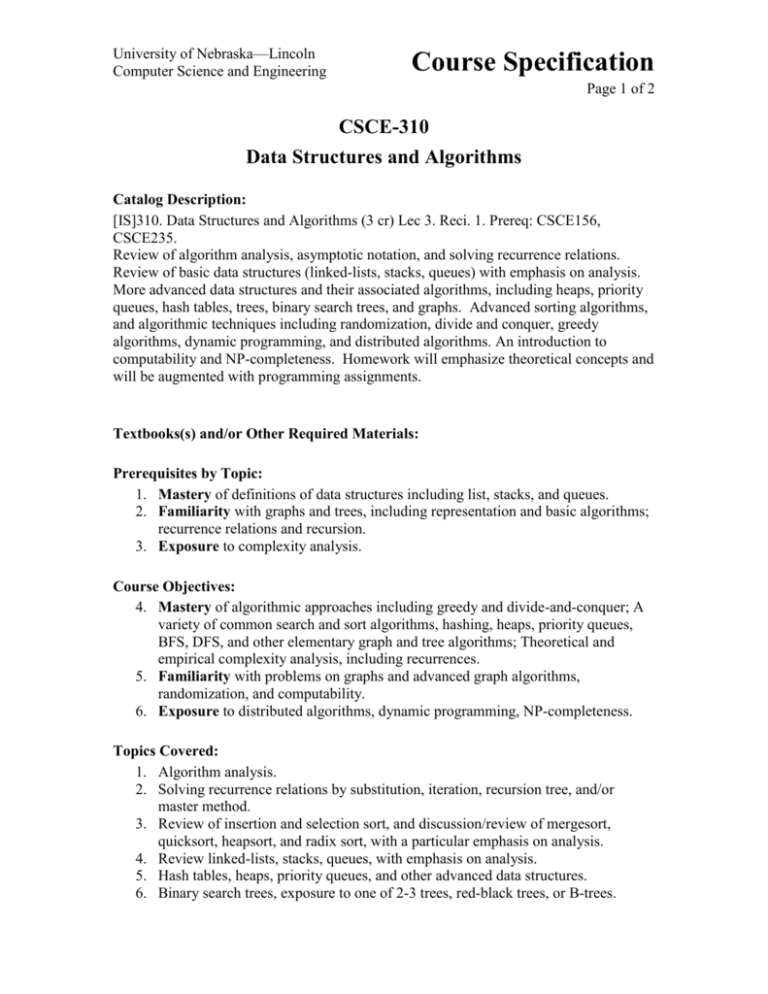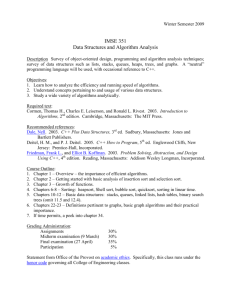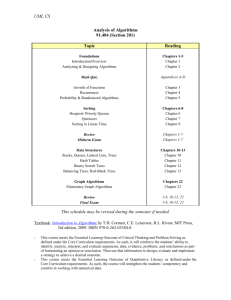CSCE310
advertisement

University of Nebraska—Lincoln Computer Science and Engineering Course Specification Page 1 of 2 CSCE-310 Data Structures and Algorithms Catalog Description: [IS]310. Data Structures and Algorithms (3 cr) Lec 3. Reci. 1. Prereq: CSCE156, CSCE235. Review of algorithm analysis, asymptotic notation, and solving recurrence relations. Review of basic data structures (linked-lists, stacks, queues) with emphasis on analysis. More advanced data structures and their associated algorithms, including heaps, priority queues, hash tables, trees, binary search trees, and graphs. Advanced sorting algorithms, and algorithmic techniques including randomization, divide and conquer, greedy algorithms, dynamic programming, and distributed algorithms. An introduction to computability and NP-completeness. Homework will emphasize theoretical concepts and will be augmented with programming assignments. Textbooks(s) and/or Other Required Materials: Prerequisites by Topic: 1. Mastery of definitions of data structures including list, stacks, and queues. 2. Familiarity with graphs and trees, including representation and basic algorithms; recurrence relations and recursion. 3. Exposure to complexity analysis. Course Objectives: 4. Mastery of algorithmic approaches including greedy and divide-and-conquer; A variety of common search and sort algorithms, hashing, heaps, priority queues, BFS, DFS, and other elementary graph and tree algorithms; Theoretical and empirical complexity analysis, including recurrences. 5. Familiarity with problems on graphs and advanced graph algorithms, randomization, and computability. 6. Exposure to distributed algorithms, dynamic programming, NP-completeness. Topics Covered: 1. Algorithm analysis. 2. Solving recurrence relations by substitution, iteration, recursion tree, and/or master method. 3. Review of insertion and selection sort, and discussion/review of mergesort, quicksort, heapsort, and radix sort, with a particular emphasis on analysis. 4. Review linked-lists, stacks, queues, with emphasis on analysis. 5. Hash tables, heaps, priority queues, and other advanced data structures. 6. Binary search trees, exposure to one of 2-3 trees, red-black trees, or B-trees. Page 2 of 2 7. Randomization. 8. Greedy algorithms and dynamic programming. 9. Distributed algorithms. 10. Graph and tree representation and algorithms including BFS, DFS, topological sort, network flow. Minimum spanning trees, shortest paths, and/or other graph algorithms, time permitting. 11. Computability. 12. NP-completeness. Class/Laboratory Schedule: Lecture 3 hours/week, Recitation 1 hour/week Prepared by: Charles Cusack September 2002






